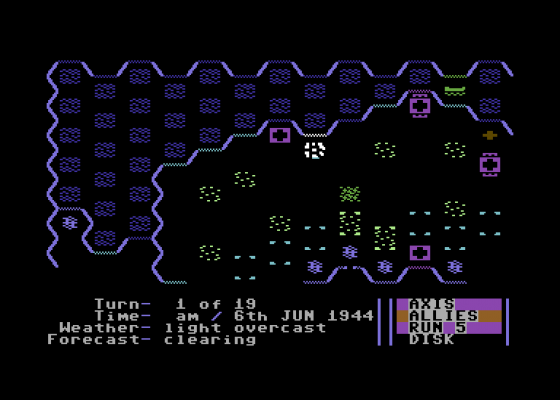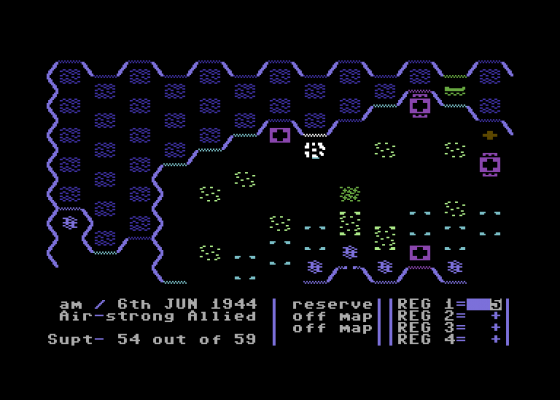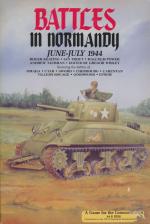
Zzap
 1st January 1988
1st January 1988
Categories: Review: Software
Publisher: Strategic Studies Group
Machine: Commodore 64/128
Published in Zzap #33
Battles In Normandy
Last month I reviewed SSG's Russia. Their latest release, Battles In Normandy, is in outward appearance a similar production. Having grappled with the meaty orders system of the former game, and more or less got to grips with the branching menus, I expected familiarising myself with Battles In Normandy would be less work. However, although the general presentation is much the same, and the on-screen appearance and packaging identical, there are many subtle and not-so-subtle differences that make Battles In Normandy far different from Russia.
The game comes in the same type of substantial fold-open card wallet as Russia, with an 80-page rulebook, reference cards printed with diagrams of the branching menus that run the proceedings, a glossy full-colour map and that thoughtful touch, a strip of labels for your save game disks. I have to make a special mention of the map because - with the somewhat irrelevant exception of the little toolkit I got in the packaging of Autoduel - it is probably the best quality component extra I've seen in a wargame. It shows Normandy, simplified into small hexes of many different types of terrain, and having diagrammatic boxes enclosing the areas in play on the screen for each scenario.
In a connected series of eight scenarios - for some reason there isn't a grand campaign game - Battles In Normandy recreates the British invasion of Normandy and the battles that were fought around the beach-heads they created. The historical analysis in the rulebook describes this campaign, from the Allies' point of view, as a 'strategic success and a tactical failure' rather than the unqualified triumph of popular conception. Recreating the actual situation is of very great importance in this game - it comes closer to being a simulation of history than most computer wargames even attempt - and this explains the complexity and the vagueness of its victory conditions. Because the Allied invasion of Normandy was a success, a player who chooses to land himself with the Axis powers in any scenario is likely to fail in an overall sense.

Victories are won and lost on points rather than the achievement of specific goals, and points are won by capturing and hanging onto 'objectives'. Capturing the objectives is not as important as retaining them, for each give points per turn. Some aren't valuable for the whole length of the scenario and only give points between specified turns. This system of rewards manages to create an atmosphere of frantic ground-grabbing - the player is advised to catch and keep every objective in sight - and it gives each scenario more flexibility than rigid conditions would.
The player can either choose sides, or set the computer against itself in 'observe' mode. Handicaps can be set either way, and act as a multiplier on victory points rather than the deployment strength or artificial intelligence routine. After these brief preliminaries, the player is free to wade through the apparently interminable tangle of menus in an attempt to make sense of the system.
There is a rather desperate sounding assurance in the manual that it all becomes perfectly simple in the end - this is true. The menus become lightning fast to manipulate, but you do have to put in quite a bit of careful studying of their function. I'm not sure that the 'tutorial' scenario is a great deal of help. It takes the bewildered beginner carefully step-by-step through 'Sword', one of the simple scenarios, but only tells one what buttons to press, rather than why. Since the rulebook is in a format virtually identical to Russia, I knew there was a detailed and comprehensive breakdown of the function of each menu in the next chapter, and I found myself continually referring forward to that as the tutorial brought me up against a new menu without explaining it.

There are sixteen different kinds of battalions, although they're not all necessarily available in a single scenario. The player is conceived as operating from a fairly lofty position in the chain of command, and controls a regiment rather than a battalion. Regiments are made up of battalions, appearing on the map and in reports as individual units, but the player doesn't have the power to specify in which hex ends up. Orders are given to the regiment, and the battalions attempt to follow them as best they can.
Each day is divided info four turns - AM, noon, PM and nite (sic) - so the timetable is quite a small one. During night turns you're not really supposed to wake your men up and force them to do things unless there's a pressing reason for it, so the action menus available for these turns are structured differently from the daytime turns to provide some degree of protection against inadvertently depriving the troops of sleep. This adds a feeling of shading and reality to the inevitably artificial turn system, and drama too - the 'Sword' scenario opens in the middle of the night, after the 6th airborne division has just landed on the beach and is planning to attack the Merville battery at 2:00am.
The regimental orders given depend very much on the position the regiment happens to be in. Its combat state is either 'ready', 'contact' or 'engaged', which is a general description of how close it is to the enemy. In a merely 'ready' state, before it has had sight of the enemy, it can be told to rest (to recover fatigue points), move forward to one of the objective hexes, seek a particular enemy battalion or deploy itself defensively around its current position. When in 'contact', after the enemy has been spotted but before it is very close, the regiment can choose from two severities of defensive action or launch a limited 'probe' attack on the nearest battalion. When 'engaged', a battalion is practically on top of the enemy, and attacks in three different ways or prepares itself for a really effective assault in the next turn. The sophistication is apparent, and the player has no control over what sort of combat state any battalion is in. The uncertainty of a real campaign, when events take on a life of their own and the leaders do not have the simplified God-like control of a wargamer, is suggested.

All orders can be manipulated until the player selects Run 5, which processes the turn. One distinct irritation about the presentation of Battles In Normandy is the lack of any description of orders given to regiments. It's easy to forget when you are controlling a large number what you told each to do, and indeed if you remembered to hand out orders to everyone.
Like Russia, Battles In Normandy offers a comprehensive design program as a major feature. Creating an entirely new scenario is a big project, but there are suggestions for minor, historically plausible variations to introduce into each pre-designed scenario. The adventurous can draw an entirely new map, using the building blocks of the sixteen terrain hexes, and the details of forces and deployment can be varied to an infinite degree. Conceivably, one could concoct a very strange and unrealistic situation, but serious users are more likely to want to type in the scenarios printed in the company's magazine Run 5.
The rulebook covers all aspects of play thoroughly. Although the tutorial isn't as helpful as it might be, the required information is found in the next chapter and the historical background material is abundant. The setting of each scenario is analysed at length, and possible tactics suggested briefly.

As before, and at the risk of repeating myself, I have to say that this is an extremely worthwhile purchase. There's hours of play in it, and designing your own scenarios is a possible hobby for life.
Verdict
Presentation 95%
Bridges the gap between computer and board wargames.
Graphics 60%
Dull, and slightly confusing.
Rules 96%
Detailed scenario analysis, full explanations of all aspects of the game system, and every other kind of help and support.
Authenticity 90%
The system of capturing objectives instead of winning outright adds greatly to the atmosphere.
Playability 86%
Some work is needed to get to grips with the menu system, but after that play becomes easy and fascinating.
Overall 90%
Another Sizzler for SSG, and a game entirely worthy of purchase.



